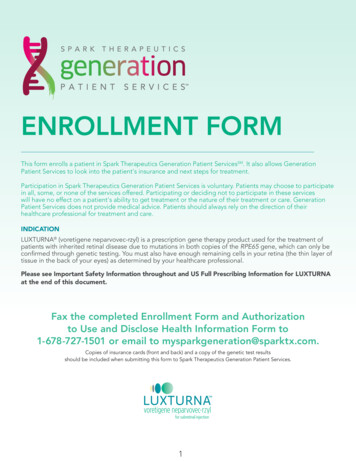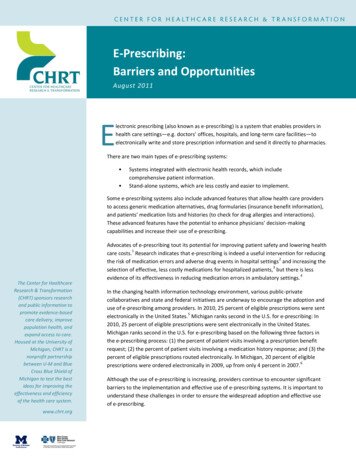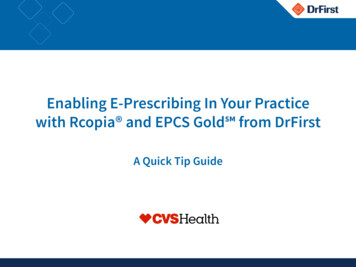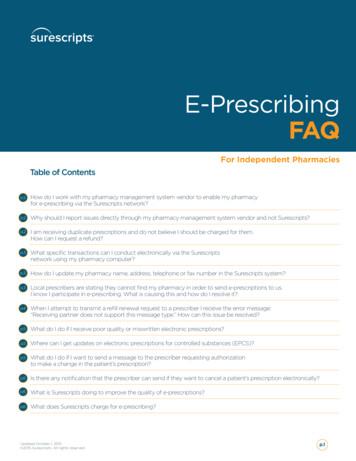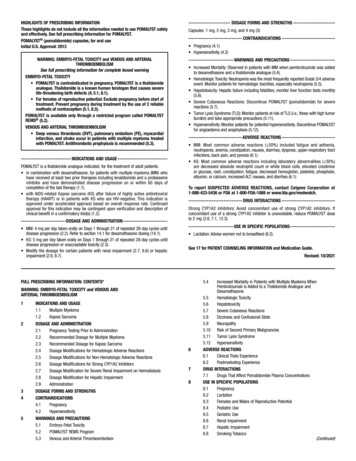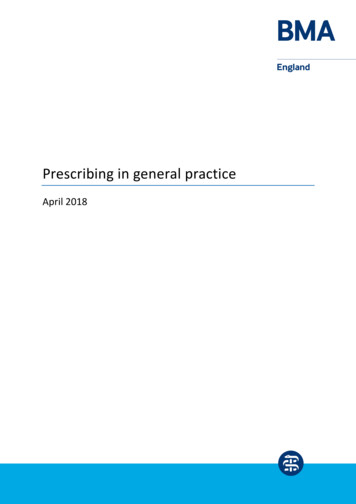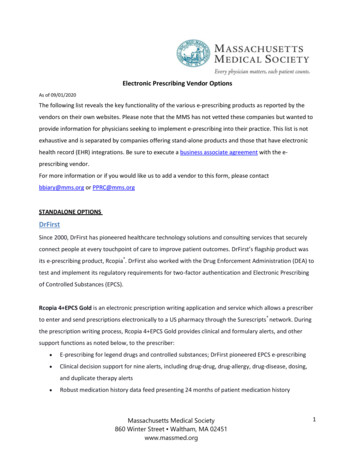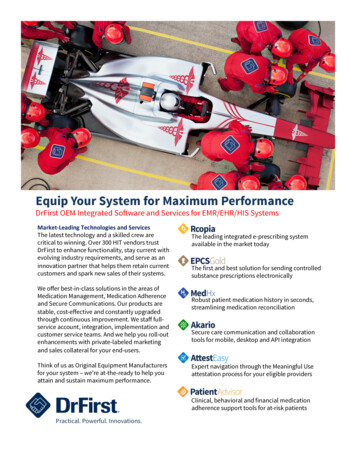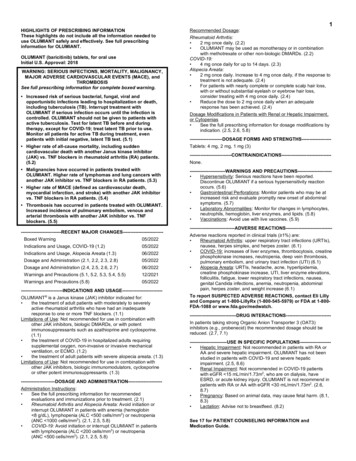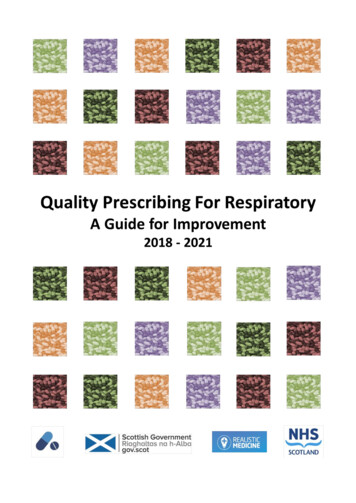
Transcription
ForewordThis guide has been written by Scottish Government and NHS Scotland to promote highquality prescribing of medicines to treat asthma and COPD (Chronic Obstructive PulmonaryDisease), and equally importantly, non-pharmaceutical approaches to management of theseconditions. The document is aimed at Primary Care clinicians, Managed Clinical Networksand Board Medicines Management Teams and builds upon the previous 2014-16 strategy.There were nearly 600,000 GP appointments relating to asthma or COPD last year.Respiratory medicines are the second most costly BNF chapter in Scotland, and althoughBoards have made significant progress in improving the quality and efficiency of care,further opportunities remain.Realistic Medicine (2016) is a key driver of strategy for NHS Scotland and includes a numberof relevant goals: Reducing the burden of overtreatmentReducing unwarranted variationEnsuring value for moneyCombining the expertise of patients and professionalsImproving the patient-doctor relationshipIdentifying and managing clinical riskThese goals are significant, and this document aims to support their delivery. It is vital that,alongside pharmaceutical care, there is a focus on education and information to enablepatients to take responsibility for their care.Specific aspects of this document have been written with a view to supporting policy on aSingle National Formulary for Scotland. The document also helps to support the enhancedclinical role of Pharmacists, as detailed in Achieving Excellence in Pharmaceutical Care.It is recognised that many people in Scotland benefit from pharmaceutical care of asthmaand COPD: this guide aims to maximise that benefit and ensure safe, appropriate care.This document is welcomed as an opportunity to further improve the quality of care topatients with asthma and COPD. There are recommendations, aimed at Clinicians, Boardsand Clusters, designed to continue improvement. We are grateful to all those whocontributed to the working group and to the review and development of the document.Colin SelbyRespiratory Lead for theChief Medical OfficerAlpana MairHead of EffectivePrescribing and TherapeuticsCatherine CalderwoodChief Medical Officer2
AcknowledgmentsThe lead authors were Graeme Bryson and Jason Cormack.Working groupJill Adams, Cardiac & Respiratory Manager, Chest Heart & Stroke ScotlandLynda Bryceland, Respiratory Nurse Specialist, NHS Ayrshire and ArranGraeme Bryson, Lead Pharmacist (South Sector), NHS Greater Glasgow and ClydeJason Cormack, Programme Lead, Therapeutics Branch, Scottish GovernmentGill Dennes, Advanced Nurse Practitioner, NHS FifeFiona Eastop, Deputy Lead Pharmacist, NHS FifeTom Fardon, Consultant Physician, NHS TaysideJohn Farley, GP with Special Interest in Respiratory Medicine, NHS Greater Glasgow andClydeCaroline Hind, Deputy Director of Pharmacy and Medicines Management, NHS GrampianSimon Hurding, Clinical Lead, Therapeutics Branch, Scottish GovernmentEmily Kennedy, Prescribing Support Pharmacist, NHS Dumfries and GallowayAlpana Mair, Head of Effective Prescribing and Therapeutics, Scottish GovernmentPhyllis Murphie, Respiratory Nurse Consultant, NHS Dumfries and GallowayPaul Paxton, Senior Information Analyst, NHS National Services ScotlandIain Small, GP & Lead Clinician Respiratory MCN, NHS GrampianJudith Thomson, General Practice Support and Development Nurse, NHS Greater Glasgowand ClydeWith thanks to:Jake Laurie, Project Support Office, Therapeutics Branch, Scottish GovernmentJaney Lennon, Prescribing Support Pharmacist, NHS Greater Glasgow and ClydeSean MacBride-Stewart, Medicines Management Resources Lead, NHS Greater Glasgow andClydeThe Scottish Practice Pharmacy and Prescribing Advisors AssociationPills Image courtesy of Piyachok Thawornmat at FreeDigitalPhotos.net3
Table of ContentsINTRODUCTION . 5POLYPHARMACY . 8RECOMMENDATIONS . 9GUIDANCE FOR CLINICIANS . 10RESOURCES FOR CLINICIANS . 10PRINCIPLES FOR PRESCRIBING FOR PATIENTS WITH ASTHMA . 11PRINCIPLES FOR PRESCRIBING FOR PATIENTS WITH COPD . 12GUIDANCE FOR BOARDS . 13RESPIRATORY PRESCRIBING ‘COST & VOLUMES’ . 13PRESCRIBING INDICATORS AND MEASURES . 15SAFE RESPIRATORY PRESCRIBING IN PRIMARY CARE . 15HIGH STRENGTH CORTICOSTEROID INHALERS AS A PERCENTAGE OF ALL CORTICOSTEROID INHALERS . 16CHILDREN UNDER 12 YEARS OLD OF AGE PRESCRIBED HIGH STRENGTH ICS AS A PERCENTAGE OF ALL CHILDREN UNDER12 YEARS OF AGE PRESCRIBED ICS . 19PATIENTS PRESCRIBED 12 SABA INHALERS PER ANNUM AS A % OF ALL PATIENTS PRESCRIBED SABA INHALER(S) . 21PERCENTAGE OF ITEMS FROM BNF SUB SECTIONS 3.1 & 3.2 PRESCRIBED BY BRAND (EXCLUDING SALBUTAMOL) . 23EFFECTIVE AND EFFICIENT RESPIRATORY PRESCRIBING IN PRIMARY CARE . 24COST PER TREATED PATIENT FOR BNF SECTION 3.2. 25COST PER TREATED PATIENT FOR ITEMS PRESCRIBED FROM BNF SECTION 3.1.2 (ANTIMUSCARINICBRONCHODILATORS EXCLUDING IPRATROPIUM) - JULY - SEPTEMBER 2016 . 27NUMBER OF PATIENTS PRESCRIBED 14 MONTHS’ EQUIVALENT OF INHALED CORTICOSTEROID INHALERS PER ANNUMAS A % OF ALL PATIENTS PRESCRIBED INHALED CORTICOSTEROID INHALERS . 29NUMBER OF PATIENTS PER 1,000 FOR BNF SECTION 3.7 (MUCOLYTICS) . 31SCOTTISH THERAPEUTICS UTILITY . 32POLYPHARMACY CASE STUDIES . 33GLOSSARY OF ABBREVIATIONS . 394
IntroductionWhat is the purpose?The purpose of this guide is to promote quality improvement in prescribing of respiratorymedicines across primary care in Scotland, particularly focussing on delivery of safe, personcentred care.In addition, it promotes self-management of respiratory conditions and disseminatesprescribing quality indicators that can be used to monitor and review prescribing andvariation in practice.The scope includes adult and paediatric patients. It is not intended to replace any currentclinical guidance and should be read alongside SIGN BTS 153 and GOLD COPD guidance.Respiratory medicine is a dynamic field with new agents and evidence being added on aregular basis. Clinicians and Boards should ensure they are aware of any relevant changes.What are the benefits to patients?The document should promote a focus on respiratory prescribing leading to structuredreview of appropriateness, efficacy and tolerability of treatment, and therefore promoteoptimal care. Through consideration of self-management, there is the potential to improvepatient engagement and the associated risk of short and long term adverse effects.In line with international evidence, there is a general shift away from a single conditionapproach to medicines strategy, and it is therefore important to consider this document inthe context of Polypharmacy Guidance and a holistic approach to care. It is important thatany guide ensures that recommendations are comprehensible, based on current guidanceand are patient focused. It must be accepted that guidelines are written to provide generaladvice and there may be some patients who require a more individual approach.What are the benefits to clinicians?The document contextualises clinical information using prescribing data to allow Boards,Clusters and individual practitioners to reflect on prioritised areas, including addressingunwarranted variation. The document is not intended to be a clinical guideline and does notreplace SIGN BTS 153.Why is this important?Asthma affects 6.4% of people in Scotland. Like the rest of the UK, Scotland has a highprevalence of asthma compared to the rest of the world. Prevalence is increasing, as is thevolume of prescribing. Asthma deaths are rising: asthma was the underlying cause of 133deaths in Scotland in 2016, up from 72 in 2014.1 There were an estimated 468,000consultations for asthma in Scotland in 2012/13.212National Records of sease/asthma/key-points5
In all there were an estimated 105,000 consultations for Chronic Obstructive PulmonaryDisease (COPD) in Scotland in 2012/13.3 It is estimated that by 2029, there will be anadditional 54,000 people in Scotland with COPD.4 The condition is under-diagnosed, with adiagnosis often only being established in the moderate to severe stages of the disease.5 It isa progressive disease that not only affects breathing but also causes weight loss, nutritionaldisturbances and muscle problems.The chart below shows relative spend on areas of respiratory prescribing in Primary Care in2015/16. The total figure of 125m represents over 10% of the Scottish Primary Careprescribing spend. 107m of this figure is made up of inhaled preventative treatments.Boards should ensure appropriate focus on safe and effective prescribing in these areas.3ISD 2017Chronic Disease Intelligence to Optimise Service Planning in Scotland – July primary-care-data46
What are the benefits to organisations?Due to increasing prevalence, Boards are seeing an increase in both volume and spend onrespiratory medicines. By BNF chapter, respiratory medicines are the third highest spend atpresent in Scotland.Included is a suite of data indicators which can help focus resources on areas which needreview. Case studies provide examples of how to implement improvements in respiratoryprescribing. The maps below demonstrate both the change in cost per treated patientacross the country, as well as the variation in this metric between Boards.7
Patient Centred Respiratory PrescribingPolypharmacyMedication is by far the most common form of medical intervention, with 300,000prescriptions issued every day in Scotland. The term polypharmacy itself just means manymedications and has often been defined to be present when a patient takes five or moremedications. However, it is important to note that polypharmacy is not necessarily a badthing. Polypharmacy can be both rational and required. It is therefore crucial to distinguishappropriate from inappropriate polypharmacy. Inappropriate polypharmacy is present whenone or more drugs are prescribed that are not or no longer needed or where there aredangerous interactions between medicines.6Scottish Government Polypharmacy Guidance can be found here. It is now more commonfor patients in Scotland to have two or more long term conditions than only one. The chartbelow indicates the relative co-prevalence of conditions. COPD is one of the most commonco-morbidities of other long term, conditions, including heart and respiratory disease,cancer and diabetes.7 Data for asthma is not currently available, but similar issues wouldapply.Multiple conditions in Scotland 86Polypharmacy Guidance 2015, Scottish GovernmentBarnett K, Mercer SW, Norbury M, Watt G, Wyke S, Guthrie B. The Lancet;380(9836):37-438Mercer, Guthrie, Wyke: Scottish School of Primary Care78
RecommendationsClinicians should Develop a clear management plan collaboratively with patients, including regular reviewdates. Expectations should be addressed and clarified based on what matters to me.Pursue non-pharmaceutical approaches wherever possible, either alone or in conjunctionwith medicines. Self-management should be actively encouraged and supported forappropriate patients.Follow a clinically appropriate approach to initiation of medication, discussing risks andbenefits and incorporating agreed criteria for stopping/continuing medication. Inhalertechnique remains a key component of co-production of positive clinical outcomes.Therefore, review of technique should be undertaken as a priority.Review effectiveness, tolerability and adherence on a regular basis. Medicine burdenshould be reduced where possible, in line with Polypharmacy guidance.Boards should Consider the guidance within this document alongside the data provided on relativeprescribing positions and trends. Prescribing action plans set out local priorities for howBoards will continue to improve quality of medicines management – these action plansshould, where appropriate, encourage use of this document to drive that improvement.Nominate a local lead from within Medicines Management and a local clinical lead fromwithin the local Managed Clinical Network or Respiratory Community. The two leads shouldwork closely together to drive delivery and implementation of the recommendations withinthis document.Ensure the primary/secondary care interface is appropriately developed. Given theconsiderable influence that local secondary care prescribing culture has on primary careclinicians, it is vital to ensure engagement with secondary care clinicians. Encourageownership of primary care data by clinicians in both settings.Review local prescribing pathways and support clinicians, based on updated SIGN guidance.Ensure non-pharmacological management is promoted within prescribing action plans.Clusters should Engage with local Medicines Management Teams to review data and consider utilising aQuality Improvement based approach to delivering change. Prioritise this area of prescribingas an opportunity for engagement.9
Guidance for CliniciansClinicians should optimise prescribing of medicines, reduce harm for patients and to reducewasteful unjustified variation. There are a number of principles which should be considered: Asthma and COPD are individual to the patient and any therapeutic management planneeds to place the patient at the centre. The approach should be based on assisting thepatient to achieve goals which have been identified in partnership with the prescriber,adopting the what matters to me principle.Prescribers should help patients to develop self-management and non-pharmaceuticalapproaches to the successful achievement of goals, where appropriate.Difficult and honest conversations may be required to establish an understanding withthe patient that it is highly unlikely that the therapeutic management plan will result infull resolution of their symptoms, but it may assist them with coping.Inhaler technique remains a key component of positive clinical outcomes. Therefore,review of technique should be undertaken as a priority. This is of particular importancedue to the growing variety of inhaler devices – ongoing review is recommended. Resources for cliniciansMy Lungs My LifeMy Lungs My Life is a comprehensive, free website for anyone living with COPD, asthma orfor parents/guardians of children with asthma. The resource is a collaboration betweenNHS, third sector and the University of Edinburgh.9In addition to general information regarding conditions, videos demonstrating technique ona number of the most commonly prescribed inhaler devices are provided. These may beconsidered useful when initiating or changing inhalers at a patient level.Don’t Waste a BreathThe Don’t Waste a Breath website, developed by NHS Grampian, provides information forpatients on inhaler technique and how to recycle inhalers. This website complements MyLungs My Life and is aimed directly at patients.Personal Asthma Action PlansThere is substantial evidence to support the value of personalised actions plans for asthmain both adults and children.10 Clinicians should refer to local guidance and resources. Ageneric template is also available from Asthma UK.Stepping down of Chronic Asthma DrugsFollowing a period of stable asthma, clinicians should consider stepping down treatment.This resource on the BMJ website provides a helpful reference source.9www.mylungsmylife.orgSIGN 153, Chapter 51010
Principles for prescribing for patients with asthmaPrincipleDetailNon pharmacologicalmanagement Pathways PatientUnderstanding Timely Review Ongoing Review Effective Care High RiskGroups 1112Patients should be supported to stop smoking. Parents should beadvised of the adverse effects smoking has on children and offeredappropriate support.11Weight reduction is recommended in obese patients and patientsshould be encouraged to engage in appropriate physical activity.SIGN 153 pathways are recommended.Choice of therapy should be directed by formularies and localprescribing guidelines.It is important that patients understand their condition as far aspossible and have appropriate expectations. It is vital the short andlong term treatment plan, and any changes are discussed with andagreed by the patient along with arrangements for repeat prescribing.A personalised action plan is key to this approach, with focus oninhaler technique, compliance and avoidance of new trigger factors.Clinicians should support use of My Lungs My Life.Any drug initiated for asthma should be subjected to timely, frequentand recorded review with the patient.It should be titrated up to a dose which balances maximum clinicalefficacy with minimal risk, and stopped if found to be ineffective or ifadverse effects outweigh benefits.Once the dose is stable and effectiveness has been established,ongoing recorded review should occur as clinically appropriate for theindividual patient, with follow up as required.This review should: confirm ongoing need for and effectiveness ofmedication; screen for side effects; review inhaler technique; andadjust dose or discontinue prescription as appropriate.A holistic Polypharmacy approach is recommended.Following a period of stable asthma, clinicians should considerstepping down treatment, as recommended by current guidelines.12Exacerbations should be considered as an opportunity to reviewtherapy and ensure treatment is optimised.Decreasing therapy once asthma is controlled is recommended.SIGN 153 suggests reductions be considered every three months,reducing by 25%-50% each time.Take into consideration any of the high risk patient groups and riskfactors when making prescribing decisions. This may include patientsprescribed high dose steroids or those with multiple morbidities.If appropriate, patients on high dose steroids (both oral and inhaled)should be provided steroid warning cards. Patients receiving highquantities of SABAs should be reviewed as indicated by NRAD.Non-attenders should be followed up – alternative strategies toencourage engagement may be required, for instance engagementthrough community pharmacy and telehealth.SIGN 153 Section 6Gionfriddo, et al. Why and how to step down Chronic Asthma Drugs. BMJ2017;359:J443811
Principles for prescribing for patients with COPDPrincipleNon pharmacologicaltreatments PathwaysPatientUnderstanding Review Effective Care High RiskGroups DetailSmoking is the primary causal factor in COPD. Patients should besupported to stop smoking wherever possible.Any pharmacological interventions should be carried out inconjunction with a structured pulmonary rehabilitation programme.Clinicians should refer to local guidance.Clinicians should encourage patients to engage in an appropriate levelof physical activity.The Global Initiative for Chronic Obstructive Lung Disease (GOLD)pathway is recommended for assessment and management.Choice of therapy should be directed from formularies.It is important that patients understand their condition as far aspossible and have appropriate expectations. It is vital the short andlong term treatment plan, and any changes are discussed with andagreed by the patient along with arrangements for repeat prescribing.A supported self-management plan, with patient education, may bebeneficial in some patients.This may include the provision of emergency drug treatments, such asantibiotics and oral steroids. However, this should only be provided tothose patients assessed as having a clear understanding of theirconditions and the functions of their medicines.Any drug initiated for COPD should be subjected to timely, frequentand recorded review with the patient.It should be stopped if found to be ineffective or if adverse effectsoutweigh benefits.A holistic Polypharmacy approach is recommended. This provides theopportunity to step down medicines where appropriate.Exacerbations should be considered as an opportunity to reviewtherapy and ensure treatment is optimised.Patients should be treated in a manner appropriate to theirsymptoms, using the pathways within GOLD.Inhaled steroids should be prescribed in line with product licenseswhere possible, taking into account health technology appraisaladvice from SMC.Mucolytics should be stopped if there is no clinical impact.Take into consideration any of the high risk patient groups andpatient risk factors when making prescribing decisions.This may include patients prescribed inhaled steroids or those withmultiple morbidities.Polypharmacy based case studies are available in the appendix.12
Guidance for BoardsRespiratory Prescribing ‘Cost & Volumes’The table below shows respective costs of medicine classes in primary and secondary care,for NHS Scotland.Table showing respiratory prescribing cost by class of medicine, Financial Year 2016/17.Class of Respiratory MedicineCOMBINATION ICS & LABALAMAICSSABALABAMUCOLYTICS FOR COPDLRAMUCOLYTICS FOR CFCOMBINATION LABA & LAMASAMATHEOPHYLLINECOMBINATION SABA & SAMAMISCELLANEOUSOMALIZUMABPrimary Care 65,144,890 28,649,106 9,339,415 9,211,469 2,972,648 3,289,447 1,129,811 1,143,789 2,247,752 324,142 360,688 190,503 109,201 6,404Secondary Care 1,984,525 1,459,608 200,207 265,195 67,908 96,929 9,738 10,560,538 116,790 56,424 20,586 31,619 85,715 2,741,432Sum: 124,119,265 17,697,214The majority of spend in Primary Care consists of preventative management of long termconditions. In secondary care, over half is spent on specialist treatments, reflecting lowvolume- high cost medicines. This reflects the differing priorities and challenges in therespective sectors.Within the data, the boxplot charts should be interpreted as follows: Median GP practices in NHS Board– dark grey barInterquartile range or middle 50% of GP practices in NHS Board – blue boxMaximum and minimum – whiskers, unless greater than 1.5 of interquartile rangeOutliers – ( ) GP practice value greater than 1.5 but less than 3.0 of interquartile rangeExtreme outliers – ( ) GP practice value greater than 3.0 of interquartile rangeThe three year charts utilise the mean position of the Board, each year.PRISMS/PIS data is based on medicines dispensed and does not necessarily correlate to useof medicines.The data provided must be considered within the context of local populations and localhealthcare arrangements, and provides an indicator of clinical practice. Due to the complexnature of the prescribing being analysed it is not possible to provide advice on what goodlooks like.13
The chart shows trends within respiratory medicines, in primary care in NHS Scotland.The graph above shows that the spend on preventative treatments takes up the bulk ofprescribing in primary care. Combination ICS and LABA inhalers remains the area of highestspend with LAMA inhalers the area of highest growth.The graph below shows the increase in LABA/LAMA combination inhalers since 2014.Triple therapy inhalers (ICS/LABA/LAMA) for COPD are now available. Boards should beaware of this development and note that this may influence clinical practice and prescribingtrends, depending on SMC advice and future integration into clinical guidelines.14
Prescribing Indicators and MeasuresThe next section discusses and provides a variety of prescribing data, broken down intofocus on safe, effective and efficient care. This facilitates inter Board comparison andidentifies trends of improvement. Board level case studies are also provided. Whendeveloping local initiatives, Boards may wish to make use of the resources available on thePrescQIPP website. This includes a wide variety of information and tools.In 2016 the Therapeutics Branch of Scottish Government engaged with Boards tounderstand the successes and areas of potential improvement, following implementation ofthe Respiratory Prescribing Strategy 2014-16. This showed that there was consistency inapproach to engagement. At an individual prescribing indicator level, success has beenachieved through development of relationships between primary and secondary care. Anumber of Boards, including NHS Tayside, NHS Grampian and NHS GG&C, have developedlocal initiatives with community pharmacy to support improvements in respiratoryprescribing. The recommendation for Boards in the future will be to develop a culture ofshared ownership of primary care prescribing data, recognising the role and influence ofsecondary care clinicians.Safe Respiratory Prescribing in Primary CareNHS Scotland has a long standing approach towards improving safety of respiratoryprescribing in primary care, particularly towards stepping down high dose steroids forpatients with asthma.The previous strategy included information on prescribing out with guidelines. Thisprovided, within its therapeutic principles, the need to review patients on high dose steroidsfor asthma and the appropriateness of steroids within treatment of COPD.This document aims to continue focus in the following key areas: High dose steroids in adults with COPD and asthmaHigh dose steroids in paediatric patients with asthmaPatients over-prescribed reliever treatmentsPrescribing of inhalers by brandThese are described in more detail in this chapter.Boards should reflect on these areas, the available local and national data and ensureappropriate priorities are delivered within plans, including, prescribing action plans.15
High strength corticosteroid inhalers as a percentage of all corticosteroid inhalersAsthmaHigh strength ICS has been a long standing priority for prescribing improvement in NHSScotland. It remains a National Therapeutic Indicator.There are safety concerns regarding the inappropriate use of high strength corticosteroidinhalers and the importance of ensuring that the patient’s steroid load is kept to theminimum level, whilst effectively treating symptoms. It is recognised that some patients willrequire treatment with high-dose ICS.There are recognised, potentially serious, systemic side effects from ICS. The mostconcerning is adrenal suppression, but others include: growth failure; reduced bone density;cataracts and glaucoma; anxiety and depression; and diabetes mellitus.13,14Of particular concern is the use of high-dose ICS in children. A UK observational study foundthat high-dose ICS prescribing occurred in 5.6% of the under 5s and 10% of the 5 to 11 yearolds. In addition very high-dose ICS ( 800 micrograms beclometasone or equivalent) wasprescribed to 3.9% of the under 5s and 4.9% of the 5 to 11 year olds.15Advice in early 2016 for children on ICS can be summarised: Regular growth monitoring (unreliable indicator of adrenal suppression)High-dose ICS should be used only under the care of a specialist paediatricianAdrenal insufficiency should be considered in any child with shock and/or reducedconsciousness who is maintained on ICSPatients should be maintained at the lowest possible dose. This is a dynamic processrequiring stepping down therapy. Reductions in dose should be considered every 3 months,reducing the dose by 25 to 50% every time. This report uses the updated definition of highdose steroids (both for adults and children) as of August 2016.16COPDThe place in therapy of inhaled corticosteroids for COPD is covered under the GOLDguideline. Prescribing of steroids in COPD should also take into account individual productlicenses/marketing authorisations and health technology appraisal advice from SMC.At present, there is a developing evidence base for the respective benefits of LABA/LAMAand LABA/ICS inhalers. This may influence future clinical practice and prescribing trends.13141516BNF 72AM J Med 2010; 123: 10016Thomas M et al. Br J Gen Pract 2006; 56: 788-90http://www.sign.ac.uk/assets/sign153.pdf16
The charts below demonstrate inter and intra Board variation in prescribing of high strengthICS.17
Case Study – NHS Forth Valley – High Strength ICSBackgroundIn 2014, in terms of the Respiratory NTI: High strength corticosteroid inhalers, Forth Valley(FV) was an outlier in comparison to the other 13 Boards in NHS Scotland, having the highestlevel of high strength inhaled corticosteroids (ICS) as a percentage of all corticosteroidinhalers (items) in Scotland.The Key ComponentsCurrent prescribing practice was reviewed and several approaches adopted as detailedbelow, to support change to established practice and improve the quality, saf
6 In all there were an estimated 105,000 consultations for Chronic Obstructive Pulmonary Disease (COPD) in Scotland in 2012/13.3 It is estimated that by 2029, there will be an additional 54,000 people in Scotland with COPD.4 The condition is under-diagnosed, with a diagnosis often only being established in the moderate to severe stages of the disease.5 It is

